(For my friend Shri Kannan Rangachar )
Continued from Part I
(Said to be a contemporary portrait in the collection of Dr. Jinararajadasa , of the Theosophical Society)
[At the outset, it needs to be mentioned that there is no single authentic account of Sri Tyagaraja’s life. Attempts to reconstruct his life-events based on references that occasionally occur in several of his songs have no real validity. Some of such narrations are but imaginative elaborations.
Even as early as in 1904, that is about 50 years after the departure of Sri Tyagaraja , Sri Subbarama Dikshitar (1839-1906) – the grandson of Sri Mutthuswamy Dikshitar ; and, who as a child had met Sri Tyagaraja – remarked that “ he could not easily obtain historical information about Sri Tyagaraja” ; and, had to rely on other sources.
What we know of Sri Tyagaraja’s life has come down to us through a series of narrations made by his disciples, their descendants and other writers.
The earliest biography of Sri Tyagaraja was written by his direct disciple, Walajapet Venkataramana Bhagavatar along with Tanjavuru Rama Rao. According to some accounts, Venkataramana Bhagavatar was with his master for about thirty years. He is also credited with writing down most of the Tyagaraja-kritis that have come down to us. Similarly, Tanjavuru Rama Rao was the Manager who took care of Tyagaraja’s household. He served his Master for long years.
Their narration was followed by that of Venkataramana Bhagavatar’s son Krishnaswamy Bhagavatar, who was with Sri Tyagaraja only during the last two years of saint’s life. His version was largely based on the notes made by his father; but, he added certain elements of his own.
Krishnaswamy Bhagavatar’s work was followed by that of his son K. K. Ramaswamy Bhagavatar who enlarged it further.
In the meantime, a biography in poetic form was written by Tumu Narasimhadasa, a Ramabhakta and an ardent admirer of Saint Tyagaraja.
These renderings were later followed by many other versions of Tyagaraja’s biography.
His direct disciples, obviously, had a very high esteem and veneration for their Guru. The image of Sri Tyagaraja that emerges from their (Venkataramana Bhagavatar and Tanjavuru Rama Rao) narration is that of a very sincere person; a truly honest follower of his Dharma; a bhaktha intensely devoted to his ideal Sri Rama; an extraordinarily gifted musical genius; a great teacher; and, a poet par excellence. He was far more than a Vak-geya-kara – the one who set words to music. He was, indeed, a divinely inspired singer of most sublime songs in glory of his Lord. He comes across as a poet, saint and philosopher combined in one. Yet; Tyagaraja, here, appears more human and real.
In the later versions of his biography , Tyagaraja is transformed and idealized as a divinity incarnate, an Avatar, a reincarnation of Sage Vyasa, of Shuka, of Prahlada, of Narada ; and, as one with an Amsha (spark ) of Shiva or Brahma. Many supernatural events and miraculous deeds were woven into his biography.
What follows here-under is somewhat closer to Venkataramana Bhagavatar’s rendering. ]
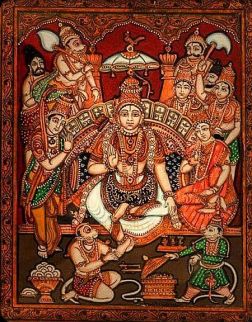
Birth
7.1. According to one account, Tyagaraja was born in Sarvajit-nama-samvatsara, Chaitra-masa, Shukla paksha, Saptami, Kataka lagna, Pushyami nakshatra, Monday, corresponding to 4th May 1767. (Another version mentions the Tithi / star of his birth as Bahula Dasami and Purvashada Nakshatra).

He belonged to Bharadwaja gotra; Aapasthamba Sutra; Krishna Yajus-shakha .
Place
8.1. The place of his birth was Tiruvarur through which the Odambokki River flows. He was named Tyaga (raja) Brahmam after the presiding deity of the temple at that place. Here, the Mulavar, Shiva Linga of precious stone, is celebrated as Tyagaraja. The processional icon of Tyagaraja in Tiruvarur temple is a composite deity comprising the images of Shiva, Uma and Skanda (Somaskanda = sa –uma –skanda).
8.2. Tiruvarur is an ancient town of the Cholas; and was one of the centres where their Kings were crowned. The temple at Tiruvarur figures prominently in Periya-Puranam, a 12th century compendium describing the lives of sixty-three Shaiva saints, the Nayamnar-s. And, by about the sixteenth century it had already come to be recognized as a seat of Sri Vidya, centered on Goddess Kamalambika. God Tyagaraja was also the Ishta-devata of the Maratha Court at Tanjavuru. The scholars and artists attached to the Telugu and Maratha court were living in Tiruvarur.
8.3. Tiruvavur (regarded as one of the sixty-four Shakthi centers); its temple complex dedicated to Lord Tyagaraja and Devi Nilothpalambika; as also the deity Sri Kamalamba, figure prominently in the Kritis of Sri Muthuswami Dikshitar. He refers to town of Tiruvarur is as Kamala-nagara (e.g. Kamalanagara viharinai) and as Kamala- pura (e.g. Kamalapura sadanam). In his Kritis, Devi Kamalamba sports in the temple lake (Pushkarini) named as Kamalalaya thirtha (Kamalalaya thirtha vaibhave). She resides in and walks about the town of Kamalapura/Kamalanagara.
[Tiruvarur has the unique distinction and honor of being the birthplace of Thyagaraja, Muthuswami Dikshitar and Syama Sastri – the Grand Trinity of Karnataka music tradition.]

Home
9.1. Tyagaraja belonged to the Telugu speaking Mulakanadu Smartha Brahmin community. In the fifth introductory verse of his Nauka charitram, Tyagaraja mentions his house-name (inti-nama) as Kakarla, which is identified as a village in the erstwhile Kurnool region of Prakasam District in Andhra Pradesh. The ancestors of Tyagaraja might have migrated from Kurnool to Tanjavuru region somewhere around the 1600s, during the Naayak rule, after the fall of Vijayanagar Empire.
9.2. Some accounts mention that Giriraja kavi Brahmam, a scholar well versed in Sanskrit and poetics, was the paternal grandfather Pitamaha of Tyagaraja. Some others say that Giriraja was in fact his Matamaha, maternal grandfather. This latter view is based on a reference (in a kriti in Bangala Raga), where Tyagaraja calls himself Giriraja suta tanaya (son of Giriraja’s daughter). Some say that expression, actually, refers to Ganesha son of Parvathi , daughter of Parvatha (Giri) raja. But now, generally, Giriraja is regarded the paternal grandfather of Tyagaraja.
[Sri Subbarama Dikshitar in his Vaggeyakara Caritam (Biographical Notes on composers and musicians), which is numbered as Volume V , under his monumental work Sangita –Sampradaya-Pradarshini, while writing about Sri Tyagaraja , on page 16, (28. Tygarajayya), commences with the statement : Approximately 250 years ago, there was a great Brahmin Giriraja Kavi in Tiruvarur. He had five sons. The youngest son was named Ramabrahmam. He was an expert in the science of Vedas. He had three sons, Pancapakesa, Ramanatha, and Tyagaraja.]
Tyagaraja’s maternal grandfather was Kalahastayya. He was a Veena player. Tyagaraja , in his childhood , learnt playing Veena from Kalahastayya.
9.3. Kakarla Rama Brahmam and Seethamma are said to be parents of Tyagaraja. They had three sons, of whom Tyaga Brahmam was the third. Panchanada Brahmam and Panchapakesa Brahmam were Tyagaraja’s older brothers. The eldest son of Rama Brahmam, Panchanatha Brahmam was also called as Japyesa, after the name of the deity at Thiruvaiyaru.
9.4. It is said that while Tyagaraja was still young, the family that was living at Tiruvarur migrated to Thiruvaiyaru, at the invitation of the King of Tanjavuru, Thuljaji. The King, it is said, gifted Ramabrahmam with six acres of land and a house. And, there, in the house gifted by the King, on the Tirumanjana Street, at Thiruvaiyaru, the family resided for very long years. Sri Tyagaraja spent a major part of his life in that house.
[The house in which Sri Tyagaraja lived most of his life and produced sublime music was in existence till recently. Alas, a year or so ago, it was demolished to put in its place a modern memorial for the Saint…! ]
Tanjavuru Maratha Court
10.1. During that time, Tanjavuru was under the Maratha rule, which had a rather chequered history. The Ramabrahmam family, perhaps, moved into Thiruvaiyaru during the reign of Thuljaji who ruled from 1763-1773 and again from 1776-1787. He was said to be a rather weak administrator, but a very generous patron of arts.
 Maharaja Serfoji II of Tanjavur and his son Shivaji II.
Maharaja Serfoji II of Tanjavur and his son Shivaji II.
In 1787, Thuljaji was succeeded by his adopted son Serfoji II who then was about ten years of age.Soon afterwards, he was deposed by his uncle and regent Amar Singh who seized the throne for himself. With the help of the British, Serfoji II recovered the throne in 1798. A subsequent treaty forced him to hand over the reins of the kingdom to the British East India Company. Serfoji II was however left in control of the Fort and the surrounding areas. He reigned till 1832.
[He, sadly, was succeeded by Shivaji II (1832 to 1855) who was a weak and feeble prince with barely any authority.]
10.2. It appears that during the most part of Tyagaraja’s adult life, that is for almost 40 years, Tanjavuru was under the rule of Serfoji II (His first reign was from 1787 to 1793 and his second reign was from 1798 to 1832). He was said to be a generous patron of arts and literature; and, his reign was noted for the literary, scientific and technological accomplishments of the Tanjavuru country. The famed Saraswati Mahal Library at Thanjavur with a nucleus of Serfoji’s collection of about 80,000volumes (most of them with his scribbles on the pages) is another of his valued legacies.
Thiruvaiyaru

11.1. Thiruvaiyaru situated on the banks of the river Cauvery, 13 km from Tanjavuru gains its name by the fact it is surrounded by five rivers (Pancha-nada-kshetram); and, appropriately, the presiding deity of ancient temple there, Shiva, is celebrated as Pancha-nadi-eswaran. Tyagaraja as a boy seemed to have loved the natural beauty of the place and the rivers surrounding it. Later, in his two songs Muripiemu and Sarivedalina he refers to his region (Ee mahilo sogasaina Chola-Sima yandu) as ‘the most beautiful place in the world , in this Chola region’.
Early years
12.1. During the younger days of Tyagaraja, Thiruvaiyaru was a well regarded centre of learning in Vedas, Sanskrit and music. It is said; Tyagaraja had his initial education in Sanskrit in Thiruvaiyaru. He seemed to have been a studious and a rather serious minded boy. He gained sufficient proficiency in Sanskrit. Several of his early songs are completely in Sanskrit (For instance; “नमो नमो राघवाय अनिशं” in Desi-Todi, said to be his first Kriti). And, two of his plays – Naukacharitram and Prahlada Bhakt Vijayam – have some slokas in Sanskrit. All his Telugu songs are replete with Sanskrit words and phrases.
12.2. During his childhood he also had his initial training in music from his maternal grandfather Kalahastayya as also from his mother Seethamma who was fairly proficient in music; and, was also a good singer. She taught her son to sing the keerthanas of Bhadrachala Ramadasu and the padas of Purandaradasa. She was also an ardent devotee of Sri Rama; and, was the first to plant in him the seeds of Rama-bhakthi. Tyagaraja, had his Upanayana at the age of seven; and, at the age of eight, he was initiated into Rama-mantra by his father. Thereafter, he started assisting his father in the daily worship of Sri Rama.
12.3. The boy Tyagaraja also learnt to play on Veena from his maternal grandfather Veena Kalahastayya (even in the later years, there used to be a Veena in Tyagaraja’s Puja-room). After Kalahastayya’s death, Tyagaraja found in his box “Naradeeyam“, a palm-leaf text related to music. Tyagaraja tried to study the text; but, could not make much of it , as many portions of the manuscript were not clear to him. He then approached his Guru Ramakrishnananda, who guided and initiated the boy Tyagaraja into Narada mantra
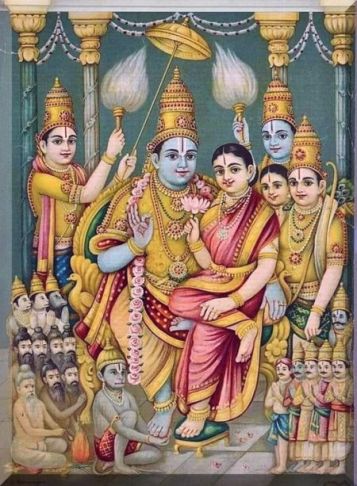 .
.
13.1. Tyagaraja , even as a teenager was deep into the Bhajana sampradaya – singing devotional songs, in group, with great fervour- which was at its height in the Cauvery delta at that time. During a Bhajana sessions which lasted for hours, a cycle of religious hymns consisting Namavali, Kirtana, Dhyana Slokas, Mangalas, Divya Nama Kirtans and other hymns were sung. Nama-sankirtanam became his devout passion.
13.2. In the Bhajans that were held in the homes or in the halls (Bhajana-mandali), the groups celebrated special festivals such as Seetha-Kalyana, Rukmini-Kalyana, Radha-Kalyanam etc with great enthusiasm, singing in chorus devotional songs that followed a certain traditional pattern (paddathi). The songs commenced with welcoming the Lord (Heccharikaga raara) ; offering him seat (kolavu) ; then the actual wedding (kalyana mahotsavam) ; waving of light (Aarathi) ; putting the Lord to sleep by singing soothing songs (Lali) ; and , waking him up next morning (Suprabhatam). For the use on these occasions, Tyagaraja composed a set of songs (numbering about twenty-seven) that have come to be known as Utsava-sampradaya-kirtanas. They are simpler in structure; but, rich in melody and lyrics. Tyagaraja also composed many other songs (about seventy-eight) – Divya-Nama-sankeerthanam – that celebrate the glory of the Lord and his name. Songs selected from these two sets are now rendered by musicians in the later part of their concerts.

[Speaking of Rama-Bhakthi: Tiruvarur where Tyagaraja was born and Thiruvaiyaru where he lived all his life, are both Shiva-kshetras; and there are no Rama-temples anywhere nearby or in the surrounding regions. Some, therefore, wonder how Tyagaraja could develop devotion towards Rama. It is explained; the forefathers of Tyagaraja’s parents hailed from Kurnool region and were devoted to Sri Rama at Bhadrachalam. Seethamma, Tyagaraja’s mother, on her marriage, brought with her the idol of Sri Rama that resembled the mulavar at Bhadrachalam , on the shores of the Godavari.
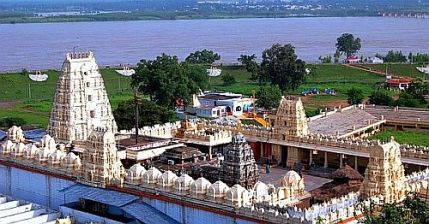
Here, Sri Rama is depicted with four arms holding a bow and arrow in His lower hands and Shanku and Chakra in His upper hands. Sri Rama is seen seated in yogic posture with Sri Sita–ammavaru is sitting on His left lap, unlike in other versions where She is standing beside Him. Sri Lakshmana with bow and arrow, devotedly guards them.

Tyagaraja’s mother worshipped this family deity (kula-devatha) daily; and, so did Tyagaraja’s father Ramabrahmam. Tyagaraja , as a boy, used to assist his parents in their daily-worship. Further, Tyagaraja’s mentors Sri Upanishad Brahmendra as also his Guru Sri Ramakrishnananda were ardent Rama-bhaktas. All these factors and Tyagaraja’s own inclination (samskara) perhaps led to imbibing in him unwavering faith and intense devotion in his Ishta-devata Rama whom he regarded as the Supreme deity, Para-Brahman. Tyagaraja is said to have performed Rama-koti-japa several times over, during his lifetime. ]
![]()
Family Life
14.1. Of the two elder brothers of Tyagaraja, Panchapakesa Brahmam died fairly early in his life because of ill health. His older brother Panchanatha Brahmam (also called as Japyesa) settled down as a householder taking care of agricultural lands.
14.2. The accounts that have come down say that Japyesa, did not like Tyagaraja’s ways; disapproved his Unchavriti, Bhajana, Rama puja etc.; and, that he also partitioned the family house and belongings. Japyesa is also said to have repeatedly pressed Tyagaraja into accepting royal patronage. It seems that Japyesa, realizing his younger brother’s rich musical talent, was anxious to turn it into a means of living . Sri Tyagaraja in his songs sometimes refers to the difficulties he had to undergo at the hands of his elder brother.
[There are also comments to suggest that Japyesa’s villainy came to be exaggerated in the later accounts perhaps to project or to heighten Tyagaraja’s misery.]
14.3. Even outside his family, Tyagaraja had to face many detractors. Many seemed to have disliked his appearance, his activities and his songs. A large number of Tyagaraja’s songs are high-strung emotional appeals to Sri Rama to rescue him from his hostile detractors. For instance; in his prarabha-mittundaga he bemoans his fate; and in his Sarivaarilona, he pleads with Rama ‘have I not been ridiculed enough; is it fair on your part to be passive while I am subjected to every sort of agony by these prattlers?’
14.4. Tyagaraja, however, vowed to lead a life of voluntary poverty, in the true traditions of Bhagavatas. He adopted for his livelihood the Unchavriti, going out everyday around the streets of the town, singing the Lord’s songs and receiving handful of rice from householders who might feel like offering. He was intensely committed to avoiding Nara-stuti, praising mere mortals in return for rewards.His Kriti Nidhi-chala sukhama , Ramuni sannidhi chala sukhama (in Raga Kalyani) is said to give expression to his attitude in that regard. (But, there is some debate about the context in which the song was composed)
Tyagaraja’s actions guided by his cherished principles and faith caused him much trouble and misery. And, these incidents, his anguish and prayers to Rama to rescue him became the subject matter of many of his songs.
[“In appearance, it is said, Tyagaraja was a tall, lean man of brown complexion. His shoulders were broad…face stern…jaw fleshy but a little pointed at the chin…he wore thulasimala around his neck; gopi-chandana- nama on his forehead. On his right forefinger he wore a gold ring; and, on his ring figure he had a pavithra. He usually was dressed in white, silk-lined, dhoti having a brownish border with carefully made folds. He usually, wore a red silk turban with a broad unfurled tail flowing behind.

The portrait of Sri Tyagaraja created by Shri S Rajam that has come to be universally recognized is a highly idealized version of the saint as envisioned by the artist.
As a teacher, Tyagaraja was said to be very strict, often harsh, with his pupils. He would insist on the right rendering of his songs. He would also not tolerate his pupils singing light hearted amorous songs such as Javalis, which were popular at that time. ]
Events
15.1. The period between 1785 and 1791 was eventful in the life of Tyagaraja. The year 1785 was also distressful for the region of Tanjavuru, when it was affected by severe famine and political disorder. When Tyagaraja was eighteen years old (1785), he was married to Parvathi. And, when he was twenty years (1787) his father Ramabrahmam expired. When he was twenty- three (1790), his wife Parvathi passed away. A year later (1791), Tyagaraja married Parvathi’s sister Kamalamba.
15.2. As regards the other tragic events in Tyagaraja’s life; his mother Seethamma passed away in 1804; his brother Japyesa in 1812; and his wife Kamalamba in 1845 (when Tyagaraja was about 78).
15.3. Tyagaraja had only one daughter, Seetha-maha-lakshmi; and she was married (in 1810) to one Kuppuswamy Shastri of Ammal Agraharam. She had a son who was given his grandfather’s name – Tyagaraja. He, later, married one Guruvammal; but, died rather early in his life (30?), childless. With that and there ended the direct line of Tyagaraja .

[ It is said; on the occassion of the marriage of Seetha-maha-lakshmi, Sri Tyagaraja’s disciple Venkataramana Bhagavathar walking all the way from Ayyampettai to Tiruvaiyaru, carried on his head the painting of Sri Kodanda Rama, created by the artist Pallavi Ellayya, portraying Sri Rama with Sita, Lakshmana and Anjaneya (Sitaramanjaneya Pattabhishekam), to be presented to the bride as the wedding gift (Pendli Kanuka). As he entered the wedding-hall carrying that portrait, Sri Thyagaraja was thrilled at its sight ; and,instantly sang in ecstasy the Kriti ‘Nannu palimpa nadachi vachitivao…!!’ (Raga Mohana) – Oh Lord, have you walked all the way to bless me. The following is said to be a scanned copy of that portrait, stated to have been painted by Pallavi Elliah, a disciple of Venkataramana Bhagavathar: courtesy, thanks to rasikas.org ]

15.4. In regard to the other branch of Tyagaraja’s family tree, it is said, Tyagaraja’s elder brother Japyesa had a son named Pattabhi Ramabrahmam. He, in turn, had a son named Panchanda Brahman, whose son also named Pattabhi Ramabrahmam. Their descendants, it is said, still live in Thiruvaiyaru; and are in possession of the Sri Rama image that was worshiped daily by Tyagaraja.
Later years
16.1. Music for Sri Tyagaraja was not mere Sangeetha-sadhana; but was indeed the Moksha-sadhana, the path to liberation. His pursuit of Nadopasana was for the realization of Nada-Brahman who is none other than the Absolute Reality, the Para-Brahman. Sri Tyagaraja, in the heart of heart, worshiped Ista-devata Sri Rama as the Supreme deity, Para-Brahman. Sri Tyagaraja devoted his entire life for worship of Sri Rama and of Nada (Nadopasana)–Music.
16.2. All his life, Tyagaraja derived inspiration from his mentor Upanishad Brahmendra and from his Guru Swami Ramakrishnananda. Further, he was guided by the hoary tradition of the Sadashiva Brahmendra the Avadhuta and Sri Narayana Theertha, the composer of Krishna Leela Tarangini. And, all these saintly persons were Sanyasins in whom the three paths of Jnana, Bhakti and Music converged harmoniously. Tyagaraja, in the last phase of his life, yearned to embrace the spiritual order as in the manner of the noble persons (Mahanubhavulu) that preceded him.
Last days
17.1. Following the path illumined by his revered predecessors, Sri Tyagaraja, after bathing in the Cauvery and performing the usual rites, and offering gifts to the needy and to the Brahmans, entered into the order of Sannyasins on 5, January 1847. According to one version; he was initiated into Sanyasa-ashrama by Sri Brahmananda Swami (?) who offered him ocher robes (kashaya vastra) and re-named him as Nadabrahmananda.
17.2. Just a few days prior to that event, Tyagaraja in his Kritis (Giripainela and Paritapamu) mentions of the Sri Rama’s promise to bestow Moksha on him:
“I did see Sri Rama resting on a mountain top. My whole being shook out of sheer Joy. I was thrilled. Tears rolled down from my eyes. I could hardly talk; I just mumbled. Sri Rama told me, in ten days (padi pūṭla) I shall grant you Moksha”;
“Have you forgotten the promise you made while you were sailing on the Sarayu in a golden boat along with peerless Sita that you would grace me after ten days (padi putla)?”
[Here, padi pūṭa might mean ten days; or five days in case puta is taken to mean a part of the full day – as either day or as night.]
18.1. A day after he took Sanyasa, that is on 6 January 1847, Wednesday (?), on Pushya Bahula Panchami in Prabhava-nama–samvatsara, seated on the banks of Cauvery at Thiruvaiyaru, Sri Tyagaraja reached Brahmi-bhava and attained Samadhi, merging with Para-Brahman.

18.2. Each year, on Pushya Bahula Panchami, the music lovers and ardent followers of Sri Tyagaraja gather at the Samadhi on the banks of the Cauvery ,caused to be constructed through the tireless efforts of Bangalore Nagarathnamma .


Scores of disciples and music lovers celebrate, with love and reverence, the Aradhana of Saint Sri Thyagaraja Swami their Guru and the ideal whose contribution to poetry, to music, to Rama-bhakthi tradition and to the Indian ethos, in general, is truly immense and everlasting.


Sources:
Manaku Teliyana Tyagaraju: http://eemaata.com/em/issues/200809/1337.html
Tyāgarāja and the Renewal of Tradition: Translations and Reflections by William Joseph Jackson
The Power of the Sacred Name: Indian Spirituality Inspired by Mantras by V. Raghavan
Spiritual Heritage of Sri Tyagaraja by Dr. V Raghavan and C. Ramanujachariar
I acknowledge with thanks the images from Sri Chitrapau Prabhakar’s site
The Musical Works of Thyagaraja by Prabhakar Chitrapu Prabhakar
http://www.sruti.org/sruti/srutiArticleDetails.asp?ArticleId=4
The other images are from Internet

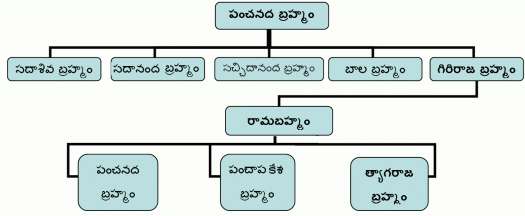
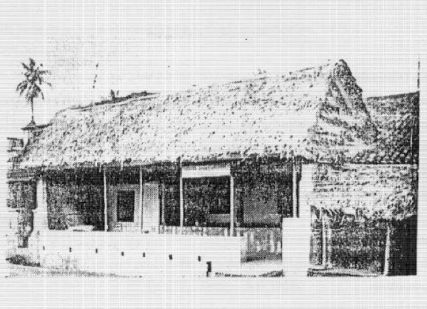


D.V.N. Sarma
December 27, 2018 at 4:07 pm
This is the first time I came across Thyagaraja’s portrait in C.Jinarajadasa;s collection. Thank you.
sreenivasaraos
December 27, 2018 at 8:05 pm
You are welcome Sir
M Siva Ram Prasad
April 18, 2020 at 1:49 pm
It is really informative and authentic with legible photographs.
sreenivasaraos
April 18, 2020 at 4:29 pm
Dear Shri Prasad
Thank you for the visit; and, for the appreciation
Regards
Beenu
July 28, 2020 at 10:46 am
Dear Sreenivasaraos,
Hope you are doing good.
I Would like to ask your permission to use the images from your website as we are doing a piece on Sri Tyagaraja + Tanjore painting.
It would be great if you please share your email id,
Requesting you to allow us.
Thanks,
sreenivasaraos
July 28, 2020 at 1:19 pm
Dear Beenu
Thank you
These images are from Internet
I think you can also use them
Cheers
Manu Rao
January 30, 2021 at 1:32 pm
Dear Sreenivasaraos,
I am doing a video on Sri Tyagaraja for our youTube channel (Naada Aarogya). Your website is extremely informative and helpful. With your permission, I would like to use some content from here. I will ensure that I give credits at the end of the video.
Thank you.
sreenivasaraos
January 30, 2021 at 2:03 pm
Dear Manu Rao
Yes Sir
As you mentioned , you may
Regards
Prof V Thirupathaiah
February 13, 2021 at 3:42 pm
Your article on Tyagaraja’ biography was extremely useful being realistic. Tnq…Prof V Thirupathaiah 9959876698 & 7989713345
sreenivasaraos
February 13, 2021 at 5:35 pm
Thank you Prof V Thirupathaiah Sir for the visit ; and , for the appreciation, which I value very highly
Please do read the other parts of the article as well
Warm Regards